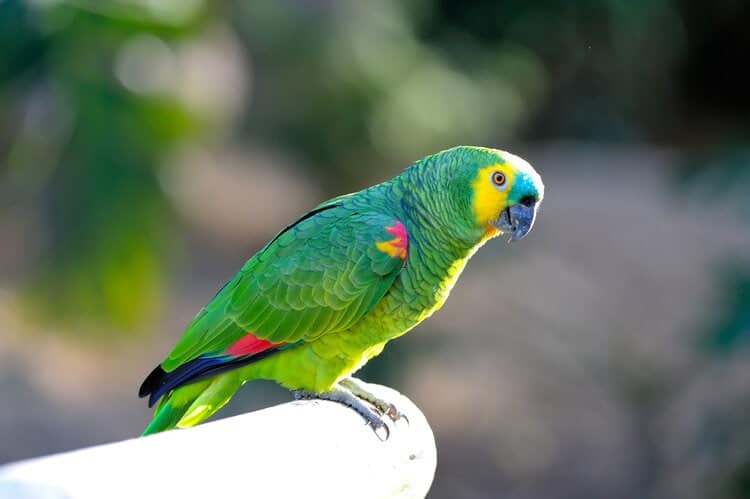
Scientific Name: Amazona aestiva
Description:
- Appearance: The Blue-fronted Amazon is a strikingly beautiful bird, known for its vibrant green plumage. The “blue-fronted” descriptor comes from the blue markings on their forehead and face, although some individuals may also display touches of yellow. They typically have a robust build, a strong, hooked beak, and a short, squared tail.
- Size: These birds are medium-sized, usually ranging from 14 to 15 inches (35 to 38 cm) in length.
- Sexual Dimorphism: There is minimal visual difference between males and females, making it challenging to determine gender without genetic testing.
Lifespan:
- Blue-fronted Amazons can live for a long time, often reaching 40 to 60 years in captivity, with some individuals living even longer given proper care.
Habitat:
- Natural Habitat: In the wild, these birds are native to subtropical and tropical regions of South America, primarily in Brazil, Bolivia, Paraguay, and northern Argentina.
- In Captivity: They require spacious cages with plenty of room to move, climb, and play. An outdoor aviary is beneficial, weather permitting.
Behavior:
- Social Interaction: They are known for their sociable nature and can form strong bonds with their owners. They require regular interaction and mental stimulation.
- Vocalization: Blue-fronted Amazons are talented talkers and can mimic human speech and sounds with clarity. They are also quite vocal naturally, with a repertoire that includes squawks and screams, particularly at dawn and dusk.
- Playfulness: They enjoy playing with toys and can be quite entertaining, but they need a variety of toys to prevent boredom.
Diet:
- In the Wild: Their diet consists of fruits, nuts, seeds, and occasionally protein sources like insects.
- In Captivity: A balanced diet is crucial and should include high-quality pellets, fresh fruits and vegetables, and limited seeds and nuts. Avoid avocados and chocolate, as they are toxic to birds.
Health Care:
- Veterinary Visits: Regular check-ups with an avian vet are important. They can be prone to certain health issues like obesity, vitamin A deficiency, and respiratory problems.
- Signs of Illness: Lethargy, loss of appetite, respiratory distress, and changes in droppings are signs that your bird may be ill.
Breeding:
- Breeding in Captivity: Breeding these birds requires a deep understanding of their needs, including a suitable nesting box and maintaining the right environment.
- Clutch Size: The female typically lays 2 to 4 eggs per clutch.
Conservation Status:
- While not currently endangered, their populations are affected by habitat loss and the pet trade. Conservation efforts are important for their continued survival in the wild.
Tips for Potential Owners:
- Time and Attention: They require significant time and attention from their owners.
- Noise Level: Potential owners should be prepared for their loud vocalizations, especially in the morning and evening.
- Long-Term Commitment: Given their long lifespan, owning a Blue-fronted Amazon is a long-term commitment and should be considered carefully.
Conclusion: The Blue-fronted Amazon is a captivating and intelligent bird, suitable for experienced bird owners who can provide the necessary care, attention, and stimulation. Their long lifespan and sociable nature make them a lifelong companion for those who are well-prepared for the responsibilities of parrot ownership.
FAQ’s
What is the lifespan of a Blue-fronted Amazon Parrot?
- Blue-fronted Amazons typically live for 40 to 60 years in captivity, with proper care and nutrition.
Can Blue-fronted Amazons talk and mimic sounds?
- Yes, they are known for their excellent ability to mimic human speech and sounds with remarkable clarity.
What kind of diet is best for a Blue-fronted Amazon?
- Their diet should consist of high-quality pellets, fresh fruits, vegetables, and a limited amount of seeds and nuts. Avoid avocados and chocolate, as these are toxic to birds.
How much interaction does a Blue-fronted Amazon need?
- They are highly social birds and require significant daily interaction with their human companions to remain mentally healthy and happy.
Are Blue-fronted Amazons good pets for families?
- Yes, they can be great family pets as they are sociable and interactive. However, they require a committed owner who can provide consistent care and attention.
Do Blue-fronted Amazons need a lot of space?
- They need spacious cages with room to climb and play, as well as regular out-of-cage time in a safe, bird-proofed area.
How can I tell if my Blue-fronted Amazon is male or female?
- Visual differences between males and females are minimal, so genetic testing or a surgical sexing procedure is needed to determine their sex accurately.
What are common health issues in Blue-fronted Amazons?
- They can be prone to obesity, vitamin A deficiency, and respiratory issues. Regular vet check-ups are important for early detection and treatment.
How do I ensure my Blue-fronted Amazon is not bored?
- Provide a variety of toys, rotate them regularly, and spend interactive time daily. Puzzle toys and foraging activities are also beneficial for mental stimulation.
Is it difficult to train a Blue-fronted Amazon?
- They are intelligent and can be trained, but it requires patience and consistency. Positive reinforcement techniques work best for teaching them tricks and managing behavior.
These FAQs provide a broad overview of the care, behavior, and needs of Blue-fronted Amazon Parrots, helping potential and current owners understand what to expect when living with these remarkable birds.
